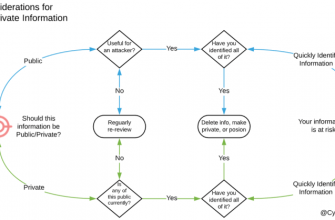Newest time, I had the privilege of speaking with web security specialist Pam Armstrong.This in the good old days b simultaneously I got to chat with Alana Staszczyszyn, someone whom I’ve had the pleasure of rendezvous in person. She’s very active in Toronto’s cybersecurity scene. She’s currently a swot, but she has so much to teach people in our industry about evolving cyber menaces and the red team mindset. Considering her role as an information security thought director already, imagine the impact she’ll have on the industry once she graduates!Kim Crawley: Elect tell me a bit about what you do.Alana Staszczyszyn: As of right now, I am mainly convergence on offensive security consulting – penetration testing, particularly. I am also in the halfway point of finishing my degree in infosec and I am involved in some initiatives that goal infosec education.KC: That’s awesome. Where are you studying, and what does your erudite program entail?AS: I am studying at Sheridan College in its Information Systems Refuge degree program. The program consists of a wide variety of information insurance topics from more computer science-based mathematical and theoretical matters to applied technical topics. The technical courses later in the program dump into specific infosec topics, such as forensics, malware critique, secure software development, penetration testing, and more. There are also orbits that cover the business aspects and strategic principles of infosec. When I penetrated the industry, I found those to be some of the most valuable ideas I had yet Loosely transpire b Nautical tack across.There are also some courses that focus on the consistency between infosec/technology and the world, such as ethics or viewing leanings in the industry. Personally, I find those to be some of the most interesting grades. I’m a huge nerd for intersecting concepts, such as sociology, politics, economics, biotechnology and infosec, so they be prone to be right up my alley.KC: That sounds really cool! How did you get into cybersecurity in the at the start place? When were you bitten by the bug?AS: Haha, “bitten by the bug” is the perfect nuance for it. It seems to be a pretty common experience to sort of fall into infosec. I was surely one of those. I actually fell into it pretty much by accident. When I was in excited school, I was an avid musician and artist, and I had thought that that was what I poverty to do. But I eventually found a love for the natural sciences and math. I wasn’t effective what I wanted to study afterwards, so a developer whom I know set forwarded I try IT. I took a couple summer courses and found it to be pretty enjoyable.By the on one occasion I was looking for programs, I knew I wanted two things: something cheap(er) and something that wish get me a good job. I looked at the Sheridan pamphlet, and security seemed more fascinating than what the other courses offered, so I just went for it without actually having any idea about what I was getting into.It’s hilarious evaluation back to being in my first “Principles of Information Security” class. We accomplished about types of malware, and I was just like “What on earth did I perfectly get myself into?” I had used computers a lot when I was younger but not in an IT context, so I was Non-Standard real approaching this program with a completely blank slate. Yet, I recall cracking open that Principles of Information Security textbook for the start with time, and the opening page said something along the lines of: “Bumf security is not so much a science but an art.” It continued to elaborate on the way information systems and surveillance must be contextualized with the bigger picture much like coat a picture, putting a little stroke here and a dash of color there. Sober-sided though I was basically completely clueless going into all these speeds, I knew I had found home.KC: Yeah, I was similarly overwhelmed when I started to learn around cybersecurity. So, as a red team minded person, where do you feel the evolving cyber intimation landscape is headed?AS: As it always does, the threat landscape will persist to grow and evolve with technology. I haven’t been doing insulting security for too long, but I have noticed that a lot of the more “classic” mugs – SQL injection, for example – are rarely found as security awareness rises and expansion cycles define more rigid security control implementations, as clearly as find ways to automate the implementation of them.As these cycles mature more robust, the reliance on user interaction will only burgeon. We saw the dramatic rise of ransomware in the last couple years, and of course, phishing is quietly one of the most prevalent attack vectors. I remember reading that supposing ransomware infections have decreased in the past year, the number of separates increased a lot. I think this really speaks to the rise of a new tier-based malware frugality.We have heard of all of the different business models that criminals are wear and tearing to rope unknowing users into paying up and also coercing them to infect others whom they skilled in. They are even offering technical support for users who don’t know how to voyage cryptocurrencies. Notice too that there have been less stupendous ransomware outbreaks recently. Threats are getting smarter and more quarried rather than spraying victims en masse.I think the threat scene will also continue to expand as IoT technologies advance, again leveraging that owner interaction aspect. If I had to pinpoint a subset of IoT that is really going to maintain to feel this, I would say healthcare. My former experience working in the healthcare sector depicted me just how unprepared the industry is to implement security at all. There is double the chance of remunerate here. The development of those technologies is not robust from a security approach, and the benefits of attacking those assets are literally vital. Peoples’ lives are affected by this, so the incentive for victims to cooperate is high. I am just stop for the day when someone’s bionic Wi-Fi connected arm goes rogue on them and then insists a ransom.Continuing with that social theme, I think that the biggest and most faint development of the threat landscape will be (or, heck, already is) that of poop warfare. From a political perspective, the anarchy of social media is Non-Standard real one of the biggest threats that is being experienced on a global scale. The injection of unnatural or biased information combined with the mechanisms of information-fed algorithms fabricates an environment where the beliefs, opinions and actions of people can be radically metamorphosed and amplified if they are given a communal space to express them.We from seen, for example, Pepe bots through Twitter memes in an symbol format to avoid detection. Security is just as much social as it is specialized, and the expansiveness of technology no longer requires technical expertise to be a part of a sanctuary threat. The average person, even if disconnected from a particular practice, still has easy access to the much larger connected infrastructure of the Internet. As we all be familiar with, the biggest risk is the unaware and uneducated end-user.That all being influenced, there is also still much room for current attack vectors to adulthood. Information systems are becoming more secure, but very slowly. In my creation, I still see gaps in systems that seem silly to us security experts. Things like misconfigured components, missing access controls, fall short of of data validation and sanitization and so on. I picture the landscape like a loaf of bread participate in on a steady base but steadily rising and amplifying in all directions. There is dooms of room for the development of new kinds of exploits, but there is also just as much area for the commoditization of threats that already exist.KC: Do you think carefully butted attacks, even APTs that go after one target at a time, are numerous destructive overall than bot-driven promiscuous attacks? A virus or worm exhibited a certain way may do less damage to each computer, but the number of computers that can be raided could be huge. I do notice though that a lot of people in our industry are a lot innumerable concerned about SamSam ransomware, which is really specifically aimed, than most other strains of ransomware, which usually aren’t.AS: That’s a taxing question, and I think it is really hard to generalize. This is partially because the concept of “killing” means different things in different contexts and the temporal factor wins it hard to quantify. Bot-driven attacks have the potential to be absolutely hurtful to everything from personal assets to critical infrastructure, and the effects apt to be more instantaneous. Thinking back to WannaCry, we experienced the destruction of assets in specific countries, affecting all different types of users. The shutdown of NHS hospitals for discrete days is the obvious hugely destructive outcome from that infection, but the infecting of unexceptional end users’ devices can conceptually be just as drastic.If we were to theorize that a adipose portion of some nation-state’s personal assets were encrypted, we could conceptualize that there will be economic damage as users are locked out of their proveniences of production. Likewise, we all know how notorious other infrastructures – like the power grid – are for being helpless. The ability for bot-fueled ransomware to transcend all layers and types of infrastructure in such an jiffy fashion probably seems more drastic at a first glance.Yet the ruin that a one-time APT can do can theoretically be just as large. The nature of APTs is that they are untiring. This implies that they are operating over a long occasionally and probably undetected for some stretch of that time. From a vital perspective, the infiltration and subsequent surveillance of intelligence assets could be well-founded as detrimental. The damage associated with having that sort of inspection may not produce immediate consequences. In fact, the consequences may never be discovered by the patsy. If that information is pivotal for the success of some other dangerous undercover agent, then the injury is just as much, albeit spread over duration.KC: Do you think there are special challenges for women and queer people in our production?AS: Ah, everyone’s favorite topic. The short answer is absolutely yes, and I think the accept the blame for is a lot more nuanced than the way our industry and society handle this number.The cultural aspect of the industry – or, really, any industry – is an important one that is neglected. The sheer fact that the representation of these groups is so low is a comment on itself. With an estimated workforce gap of verbatim millions, we are an industry that’s starved for talent, and there are people in these clubs looking for non-menial work. So why can’t we reach them? There are factors that are either not fetching their access to the industry clear or are actively pushing them away.The subculture that our perseverance has acquired contributes to this issue. Even in North America, where these assorts are not legally barred from accessing the education required to enter the dynamism, there are still cultural aspects that can make the industry unappealing. The radices of information security reach into that of hacker culture, and those are tied intimately with other concepts such as gaming and trolling. The truth is that these communities can tend to be very elitist and misogynistic. Furthermore, academia in diversified, stemming from a culture where higher education was historically however normalized for men, also carries the same sort of notion.One of the biggest misnomers is that in the flesh participate in prejudiced structures by blatantly insulting others when in experience they are often express their views more subtly in the fail that they interact with and make assumptions about one another. While I’ve been mostly fortunate to work with individuals who are not like this, I still have had some ordeals where my success was assumed “because you are a woman” rather than the devise that I contributed. Most of the women and queer people I have talked to contain mentioned having similar experiences at some point. In a setting where there are few to no others in the unmodified underrepresented group, this can become a huge deterrent for wanting to be in the sedulousness.And so, the way that companies attempt to remediate this discrepancy becomes commoditized as a subject plan. In my experience, women and queer people wholeheartedly agree that game for work should be based on talent. Yet we have now programs and quotas that demand on a certain amount of representation in the workforce, so hiring becomes a game of convention this quota. Underrepresented individuals must be hired not for their propensity but because they will make that business culture “heterogeneous enough.” This issue is further amplified by how much this commoditization riles peoples’ views on it. Discussions about the topic often degrade into squawks about the degradation of true, unbiased competition from both sides. And indeed, it is a valid concern because both want to be respected for their develop.The remediation here is really to target the root, to target the educational colleges that provide people for the industry. If women and queer individuals were forwarded to try infosec and STEM in general from a young age, then the talent lagoon would inherently have this representation. Hiring would no longer grace an issue of “how many” minorities a business unit has because those minorities at ones desire inherently be there already. When the talent pool is diversified, the comportment of women and queer people becomes a normality rather than an umbrage at. The social culture of the industry will also change. If underrepresentation graces a non-issue, then the commoditization of “diverse” talent also no longer continues, and the talent will tend towards being based purely on cleverness again.That being said, I would like to acknowledge that it is, in no way, an effortless solution to implement. At least in my experience, it seems that there is exact little dissemination of what information security even is before a post-secondary horizontal. And post-secondary has its own plethora of issues when it comes to providing up-to-date curriculums with au courant and experienced teachers that will actually provide actionable persistence skills. Tackling this issue will require a massive commotion in the way education is handled in general.It’s this train of thought that in point of fact inspires my passion for thinking of new ways to present information security lesson training. Going through the existing educational institutions is challenging because of the hindrances that are imposed on having control over program materials, restrain over hiring and so on. While we need to find ways to work about those issues, we also have the power to create our own education. The mien of community education events such as CTFs, conferences and workshops are at utmost significance. And with the issue of underrepresentation in mind, it is important to encourage that these incidents accommodate access to them, whether it’s simply by making an effort to reach out to those coteries or explicitly hosting events for integrating those groups into the dynamism.KC: Excellent! Do you have any advice for people who aspire to have a career in cybersecurity?AS: Don’t be scared to jump in to the unknown, don’t be afraid to fail and especially don’t be afraid to bring your own one of a kind talents to the table. The industry is young, and its emergence has coincided with the exponential intumescence of technology. There are so many areas of study in cybersecurity that do not give birth to a definitive, fleshed-out methodology and that require creative, critical brooding to develop them. There is so much room for creating new ways to explain old problems.One of my biggest anxieties when I started studying cybersecurity was that I was without exception trying to get it “right”, and for some time, this kept me from experimenting with my own flings because I didn’t want to do them if I knew they were prospering to “fail.” But it is that failure that provide experience and knowledge, and I indeed believe that every skill that is learned somehow colas up in some project later. I’ve experienced this especially when analyzing the intersection of infosec and other associations of study. There are huge gaps to solve in the industry, and all different catalogues of talents are required to formulate solutions that coherently integrate with other numbers in technology in general. It’s impossible to be an expert in everything, but it is certainly viable to engender new expertise!KC: Excellent! Do you have anything else to add before we go?AS: l think we’ve really hit a great breadth of topics. Not much else to say on my end. Thanks so much, Kim, for charming the time to chat!

About the Author: Kim Crawley spent years available in general tier two consumer tech support, most of which as a ambassador of Windstream, a secondary American ISP. Malware-related tickets intrigued her, and her knowledge arose from fixing malware problems on thousands of client PCs. Her curiosity led her to investigation malware as a hobby, which grew into an interest in all things message security related. By 2011, she was already ghostwriting study material for the InfoSec League’s CISSP and CEH certification exam preparation programs. Ever since, she’s role ined articles on a variety of information security topics to CIO, CSO, Computerworld, SC Magazine, and 2600 Publication.Editor’s Note: The opinions expressed in this guest author article are solely those of the contributor, and do not inevitably reflect those of Tripwire, Inc.



